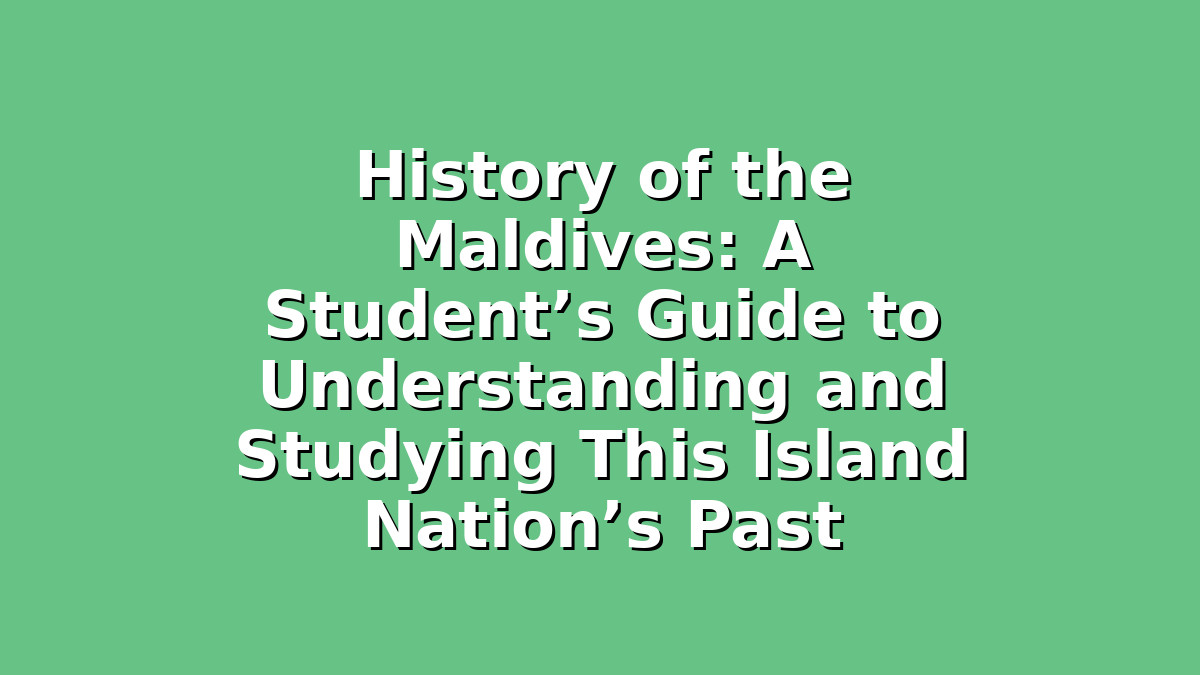The Maldives, an enchanting archipelago in the Indian Ocean, is known for its stunning beaches and crystal-clear waters. However, its history is just as fascinating and offers valuable insights into its culture, geography, and strategic importance over centuries. For students preparing for exams or looking to deepen their understanding of global history, exploring the Maldives’ past can be both enriching and manageable with the right study techniques. In this article, we’ll walk through the history of the Maldives in three key sections and provide useful study tips to help you retain information effectively.
Introduction to the History of the Maldives
The Maldives consists of around 1,200 coral islands grouped into 26 atolls, located southwest of India and Sri Lanka. Due to its location, the Maldives has been influenced by various civilizations, including South Asian, Arab, and European cultures. Understanding the Maldives’ history helps contextualize its unique cultural identity and its evolution into a modern nation. For students, breaking down this history into manageable periods and using study strategies will make exam preparation smoother and more effective.
1. Early History and Settlement of the Maldives
The earliest settlers of the Maldives are believed to have arrived around 500 BCE, likely from South Asia and possibly Sri Lanka. These settlers brought with them advanced knowledge of fishing, seafaring, and agriculture suited to island life. Early Maldivian society was organized into small communities tied together by trade and kinship.
In this period, Buddhism was the dominant religion, influenced by nearby Sri Lanka. Archaeological evidence such as stupas and Buddhist relics found on the islands indicates the strong presence of Buddhist culture for several centuries.
Study Tip: When studying early history, focus on timelines and cause-effect relationships. Create a timeline chart for the Maldives’ early history with key events like initial settlement and the introduction of Buddhism. Using visuals helps retain chronological information more clearly.
2. The Islamic Conversion and Medieval Period
One of the most significant turning points in Maldivian history was the conversion to Islam in 1153 CE. According to legend, a Moroccan traveler and Islamic scholar, Abu al-Barakat Yusuf al-Barbari, converted the king and the population to Islam after curing the king of a disease. This marked the beginning of the Maldives as a sultanate—a monarchy ruled by Muslim sultans.
The Islamic faith deeply influenced Maldivian society, law, and culture, shaping local customs and governance. During the medieval period, the Maldives maintained trade relations with Arab merchants and other Indian Ocean cultures, becoming an important hub for trade in cowrie shells, coconuts, and fish.
The Maldives also faced challenges such as foreign invasions and internal power struggles but generally retained independence due to its geographic isolation.
Study Tip: When covering religious and cultural shifts, use mind maps to connect how the conversion to Islam impacted society, politics, and trade. Associating concepts visually can help students remember complex interrelations.
3. Colonial Influence and Modern History
From the 16th century onwards, the Maldives attracted interest from European powers, including the Portuguese, Dutch, and British, due to its strategic location on Indian Ocean trade routes. The Portuguese briefly occupied the islands in the mid-1500s but were expelled by local resistance.
By the 19th century, the Maldives became a British protectorate, a status that provided some defense against other colonial powers while allowing internal autonomy. This period saw the introduction of new technologies and administrative reforms.
In 1965, the Maldives gained full independence from Britain, beginning its journey as a sovereign nation. Since independence, the Maldives has developed rapidly, focusing on tourism, fishing, and environmental preservation given its vulnerability to climate change.
Study Tip: For modern history, practice summarizing each key event in your own words and creating flashcards with dates and facts. This method aids quick recall and prepares you well for multiple-choice or short-answer exam questions.
Conclusion: How to Master the History of the Maldives for Exams
Studying the history of the Maldives involves understanding a blend of cultural, religious, and political changes over centuries. To succeed in exams, it’s important to organize your study sessions around clear themes—such as early settlement, Islamic conversion, and colonial influence—while applying effective study techniques like timelines, mind maps, and active recall through flashcards.
Remember, history is not just about memorizing dates but about understanding the stories and causes behind events. Engage with the material by asking questions like why the Maldives converted to Islam or how its geography influenced its history. This critical thinking approach will deepen your learning and make exam preparation less stressful.
Stay consistent with your study habits, take regular breaks, and don’t hesitate to use additional resources such as documentaries or interactive maps to enhance your understanding. With patience and the right strategies, mastering the history of the Maldives can be an enjoyable and rewarding part of your exam preparation.
Good luck with your studies!

Responses